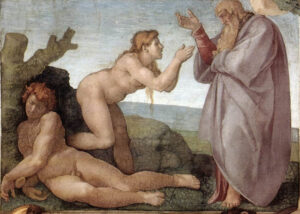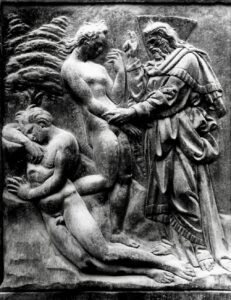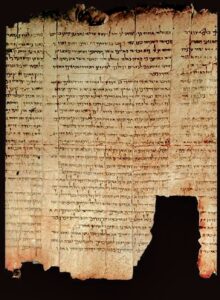Professor Enrico Bruschini
When Pope Sixtus IV commissioned the construction of the Sistine Chapel in 1477, he ordered it to have the same dimensions as the Temple of Solomon. This was made possible because those dimensions are mentioned in the Bible, in the Book of Kings (60 x 30 x 20 Hebrew cubits), which correspond almost exactly to the dimensions of the famous Chapel (40 x 21 x 13 meters).
 The Pontiff himself summoned the best artists of his time to Rome, including Botticelli, Ghirlandaio, and Perugino, to fresco the Stories of the Life of Moses on the left wall and the Stories of the Life of Jesus on the right wall. This was intended to emphasize that there was no conflict between the Jewish and Christian religions, but rather that the latter is the historical and religious continuation of the former. After the magnificent cleaning of the Sistine Chapel and a better view of the frescoes, this became even more evident.
The Pontiff himself summoned the best artists of his time to Rome, including Botticelli, Ghirlandaio, and Perugino, to fresco the Stories of the Life of Moses on the left wall and the Stories of the Life of Jesus on the right wall. This was intended to emphasize that there was no conflict between the Jewish and Christian religions, but rather that the latter is the historical and religious continuation of the former. After the magnificent cleaning of the Sistine Chapel and a better view of the frescoes, this became even more evident.
An outstanding example is “The Creation of Eve“. We admire the anatomical perfection of the two naked bodies. It’s worth remembering that Michelangelo, at the age of fifteen, used to sneak into the mortuary of Santa Maria Novella hospital to study anatomy.
 We know that Michelangelo admired and studied the magnificent reliefs by Jacopo della Quercia carved on the central portal of the Basilica of San Petronio in Bologna. They certainly influenced his work in the Sistine Chapel.
We know that Michelangelo admired and studied the magnificent reliefs by Jacopo della Quercia carved on the central portal of the Basilica of San Petronio in Bologna. They certainly influenced his work in the Sistine Chapel.
The two images are, with few exceptions, almost superimposable. Of course, we appreciate Jacopo’s work because it was created about eighty years before the fresco, but how much more vivid and “balanced” is Michelangelo’s version! We admire the vividness and stylistic perfection of the figures in the great artist’s frame.
We see how Eve is perpendicular to Adam’s body and parallel to the large dry branch behind him. We admire the perfect alignment of the heads of the three figures!
If we look closely, in the magnificent fresco, as well as in the relief, we see Eve almost “rising from the side” of Adam. But wasn’t Eve created from a “rib” of Adam? Is this perhaps a “mistranslation” of the original text of the Bible?
 We know that the oldest text of the Bible, the Tanakh, was written between 1200 and 600 BCE in ancient Hebrew, with some segments in Palestinian Aramaic. The ancient Hebrew texts were not easily readable and understandable because the words were not separated from each other, and the vowels were not indicated.
We know that the oldest text of the Bible, the Tanakh, was written between 1200 and 600 BCE in ancient Hebrew, with some segments in Palestinian Aramaic. The ancient Hebrew texts were not easily readable and understandable because the words were not separated from each other, and the vowels were not indicated.
To give an example, the title of this article “Was Eve created from a rib of Adam?” would have been written as “WSVCRTDFRMRBFDM“. By separating the words and adding the necessary vowels (in this example, they have been added in lowercase), it would be read as “WaS eVe CReaTeD FRoM a RiB oF aDaM“.
Or, by separating the words differently and adding different vowels, it could be read with other different phrases and getting different concepts.
Not only the Bible but also the famous recently discovered Dead Sea Scrolls are written in the same way!
 How many words and thoughts could have been misinterpreted from the first version of the Bible, the Masoretic Text from the second century BC, to the Septuagint, the Greek version first translated from Hebrew by the 70 sages of Alexandria in the third century BCE? And from the Vulgate of St. Jerome, who in the early fifth century A.D retranslated the Holy Bible from the Hebrew texts, not trusting the Greek translation of the Seventy, to more modern translations and versions?
How many words and thoughts could have been misinterpreted from the first version of the Bible, the Masoretic Text from the second century BC, to the Septuagint, the Greek version first translated from Hebrew by the 70 sages of Alexandria in the third century BCE? And from the Vulgate of St. Jerome, who in the early fifth century A.D retranslated the Holy Bible from the Hebrew texts, not trusting the Greek translation of the Seventy, to more modern translations and versions?
In more recent times, for the Italian language alone, at least nine different translations have been published, almost always made from the original texts. From the Malermi Bible (1471) to the latest official version of the Italian Episcopal Conference (June 11, 2013), which explicitly states: “The new translation corrects inaccuracies, inconsistencies, and errors in the translation of 1971-74“.
These various translations were made by human beings, and human beings are not infallible.
In 1996, while I was writing the Vatican Museums guidebook “In the Footsteps of Popes“, I was fortunate to come across a ponderous Hebrew-English dictionary, and I looked up the translation of the word “rib”. In Hebrew, it is “tzelàh” (or “sellàh”).
I then searched the second part of the dictionary for the word “tzelah” again and found, with some excitement, that it means not only “rib” but also “a part” or “half.” So, it could have been translated as: “The Lord molded Eve from a ‘half’ of Adam!”
This version has always seemed to me to be less offensive to the dignity of women and, more importantly, it thoroughly explains the wonderful verses of Genesis (1:26-28) – “And God created man in His own image; in the image of God He created him; male and female He created them. God blessed them and said to them, ‘Be fruitful and multiply‘“.
From the singular “him” (Adam), it immediately and naturally moves to the plural “them” (Adam and Eve)! But, after all, haven’t we always called women “our better half”?
Recently, I had confirmation of this hypothesis from the interesting book “The Secrets of the Sistine Chapel“, written in 2007 by the American art historian Roy Doliner, of the Jewish faith, and Rabbi Benjamin Blech of New York.
They asked me, a Catholic, to write the book’s preface. I accepted with pleasure because they truly discovered interesting things in the Sistine Chapel that had escaped notice until now. But we will talk about this in a future article.
Ig – @fairness_mag

